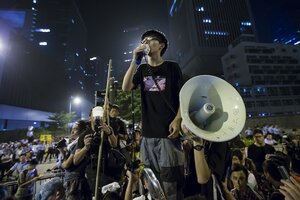Why teens often lead protests
In Hong Kong’s demonstrations, a 17-year-old leads others in the demand for full democracy from China. Like many student activists, he seeks proof of theories learned in class – and assurance of a better life ahead.

Joshua Wong, leader of a Hong Kong student movement, delivers a speech to a crowd outside the offices of Hong Kong's Chief Executive Leung Chun-ying Oct. 3.
Reuters
Mere opinion leaves him cold. At his university, he doesn’t talk politics much. He dislikes writing essays on electoral reform. He is bored by speeches of politicians. And yet for the past two weeks, 17-year-old Joshua Wong has been the face, even the leader, of the demonstrations demanding freedom for Hong Kong citizens to choose their own candidates in a coming vote for city leader.
Since age 14, when he rallied more than 100,000 people to protest against a plan to impose a pro-China curriculum in Hong Kong schools, Joshua has been one of those students who is no brick in the wall. He joins a string of teens who have put feet to theory and voice to action.
“What teacher would not be filled with joy to watch his students seize learning so independently, so concretely, and with such passion?” wrote Denise Ho, a professor at the Chinese University of Hong Kong, in a letter to her students about the student rallies for democracy.
Another activist with teen spirit has been Malala Yousafzai, the Pakistani blogger who defied the Taliban in demanding that Muslim girls be educated. For rallying people to that cause worldwide, she was nominated for the Nobel Peace Prize at age 16 and allowed to speak at the United Nations. (She has also recovered from being shot by the Taliban.)
Then there is Rekha Kalindi who, in 2007, refused to be married off in India at age 13, preferring to attend school. She became a crusader against the practice of forcing girls to be child brides.
These teens are part of a history of brave activists who, like the child whose innocence allows him to say the emperor has no clothes, only want to demonstrate in practice what they have learned and understand in their heart.
Students have often been on the front lines of protest, eager to apply their classroom knowledge. In Taiwan last March, student activists conducted a sit-in against a secretly negotiated trade deal with China, forcing the government to meet their demands on transparency. Since 2009, in protests from Iran to to Ukraine, Internet-savvy students have easily banded together to demand democracy, an echo of the street protests in the West in the 1960s and in China’s Tiananmen Square in 1989.
Are students in the United States as eager to be the Joshuas and Malalas of their own country? Or are too many students more focused on getting steady, well-paying jobs?
Many students have led the Occupy movement and demonstrations on climate change and other issues. But consider this: Two years after college, more than a third of recent graduates say they never read the news or do so only once a month, according to a survey for a new book, “Aspiring Adults Adrift,” by Richard Arum and Josipa Roksa. More than half said their lives lack direction. And all the volunteering they once did as students has dropped off. A similar survey found only a third of graduates said their civic awareness had expanded in college.
What might explain this lack of public engagement? Perhaps it might be the overparenting and overcoaching of young children, says former Yale professor William Deresiewicz. In a new book on conformity in Ivy League universities, “Excellent Sheep: The Miseducation of the American Elite & the Way to a Meaningful Life,” he writes:
“The cultivation of curiosity, the inculcation of character, the instillment of a sense of membership in one’s community, the development of the capacity for democratic citizenship, let alone any emphasis on the pleasure and freedom of play, the part of childhood where you actually get to be a child – all these are gone.”
Many colleges now are beefing up their civic activities for students. A 2012 report by the Association of American Colleges and Universities called on higher education to provide more “collective civic problem solving.”
Public protests are only one way for students to put their education to the test. Yet they are a visible example of students creating facts on the ground from the truths they learn in class. Teens who seek proof of their newfound knowledge are on the front lines for all of us.

